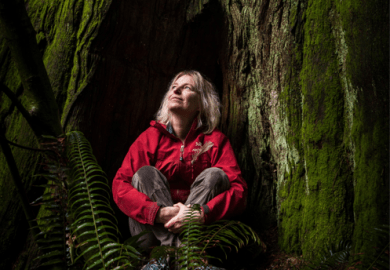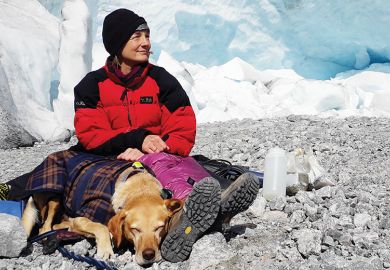These books represent contrasting contributions to the literature on glacial geology. Michael Hambrey's Glacial Environments is an undergraduate text concerned with the processes and products of modern glaciers while M. Deynoux et al's Earth's Glacial Record is a collection of research papers relating to the ancient glacial record, in particular sedimentary rocks deposited during glacial episodes in the Late Proterozoic and Late Paleozoic eras.
Hambrey states that his principal aim was to describe the processes, landforms and sediments associated with contemporary glaciers in a text that is readily accessible to undergraduates. In this he has succeeded admirably, producing a succinct account beautifully illustrated with photographs that testify to a wide experience of glaciers and glacial environments throughout the world. These photographs capture the beauty and excitement of glaciers and will surely stimulate the interest of all who read the book. The author has integrated the traditionally more "geographical" aspects of glacial geomorphology with the traditionally more "geological" aspects of sedimentology, providing sedimentologists with a better understanding of glacier systems and glacial processes, and geomorphologists with a better understanding of sedimentary processes and sedimentological techniques such as facies description and logging, and the nature of facies associations and sequence stratigraphy.
A second important aim of the book is to give a greater emphasis to the glaciomarine environment than has been the case in most previous textbooks. Offshore drilling and geophysical exploration are now generating rapid advances in our knowledge and understanding of glaciomarine processes and sediments. Fjords, continental shelves and deep-sea settings are fully discussed and illustrated not only with contemporary examples but also with examples from the ancient rock record. As a consequence of the space allocated to glaciomarine environments (82 pages), glaciofluvial and glaciolacustrine processes and landforms are squeezed into a mere 21 and 14 pages respectively. Both are well illustrated but the descriptions are brief, and it is a pity they did not receive a more detailed treatment.
The book begins with an introduction to the development of the glacial theory, sedimentological description and analysis, and the geological context. Chapter two discusses glacier dynamics, and is followed by chapters on glacial erosional processes, glacial deposition in terrestrial environments, glaciofluvial processes and landforms, glaciolacustrine processes and sediments, glaciomarine processes and sediments in fjords, and finally continental shelf and deep-sea glaciomarine processes and sediments. There is an extensive bibliography, a useful glossary and a detailed index.
The treatment is descriptive, the author having avoided the use of most mathematical formulae but given references where appropriate to works that provide rigorous mathematical treatment. While this approach may be justified in view of the anticipated readership, in some respects the book opts out of explanation of the physics underlying some of the glacial processes described. For example, pressure melting is referred to, but no explanation is given as to why the melting point of ice should be pressure sensitive. Similarly, subglacial sediment deformation is described and pore water pressure alluded to, but no explanation is given as to why the strength of a saturated sediment is sensitive to porewater pressure. Such explanations need not be mathematical. However, when set against its strengths, in providing a wide-ranging, stimulating and beautifully illustrated account that will equip students with the skills to describe and interpret glaciogenic landforms and sediments, these criticisms are minor. The book is undoubtedly destined to become a standard text.
Earth's Glacial Record, part of the World Regional Geology Series, provides a compilation of recent research on glacial sedimentology and will form a key reference for researchers and for students taking advanced undergraduate and postgraduate courses in sedimentology.
The opening paper, concerned with geodynamic controls on glaciation in earth history, by N. Eyles and G. M. Young, provides an excellent overview and context for the book. It is followed by a series of papers concerned with the affect of tectonic settings on the nature and distribution of sedimentary facies in proven glaciogenic sequences. Later papers consider the problem of apparent low latitude glacial events, as evidenced by low palaeomagnetic inclinations in many Neoproterzoic glaciogenic strata, the application of sequence stratigraphy in glacial rock successions, the nature and origin of carbonate-rich glacial sedimentary rocks, the geological evidence for glacial/interglacial transitions within the rock record, and the role of iceberg scouring of palaeosurfaces within rhythmites and diamictites.
A wide range of contributions (19 papers from 33 contributors) ensures the inclusion of sedimentological description and interpretation of a large variety of rocks in a wide variety of geographical and geological contexts.This book will undoubtedly play a significant role in the progressive emergence of glacial sedimentology from its former neglected corner into the mainstream of sedimentology. It is to be recommended for all researchers concerned with the sedimentology and interpretation of glaciogenic rocks, and will surely find a place on the shelves of university libraries where courses in advanced sedimentology are taught.
Charles Harris is a senior lecturer in earth sciences, University of Wales Cardiff.
Earth's Glacial Record
Editor - M. Deynoux, J. M. G. Miller, E. W. Domack, N. Eyles, I. J. Fairchild and G. M. Young
ISBN - 0 521 42022 9
Publisher - Cambridge University Press
Price - £60.00
Pages - 266
Register to continue
Why register?
- Registration is free and only takes a moment
- Once registered, you can read 3 articles a month
- Sign up for our newsletter
Subscribe
Or subscribe for unlimited access to:
- Unlimited access to news, views, insights & reviews
- Digital editions
- Digital access to THE’s university and college rankings analysis
Already registered or a current subscriber?



